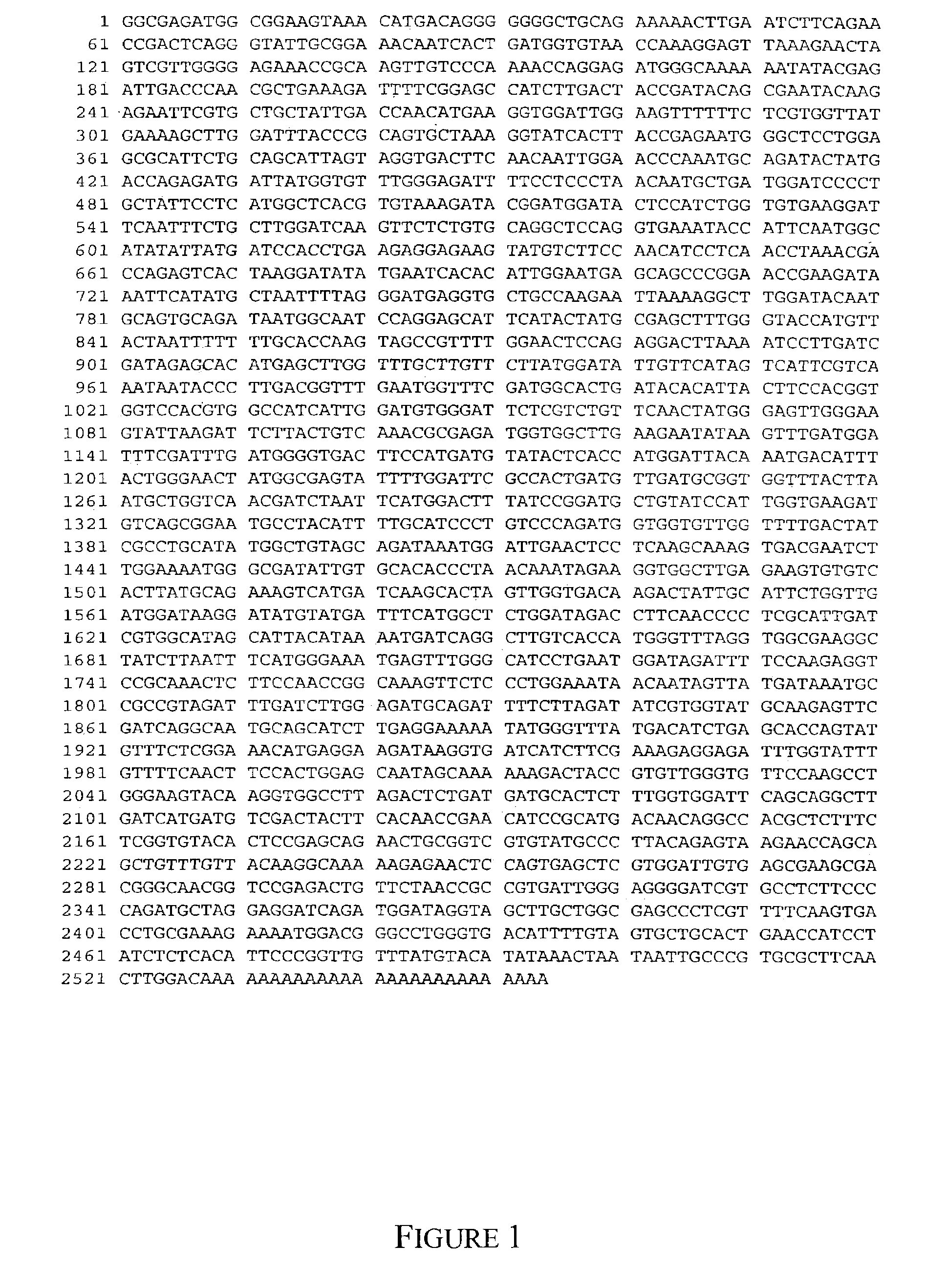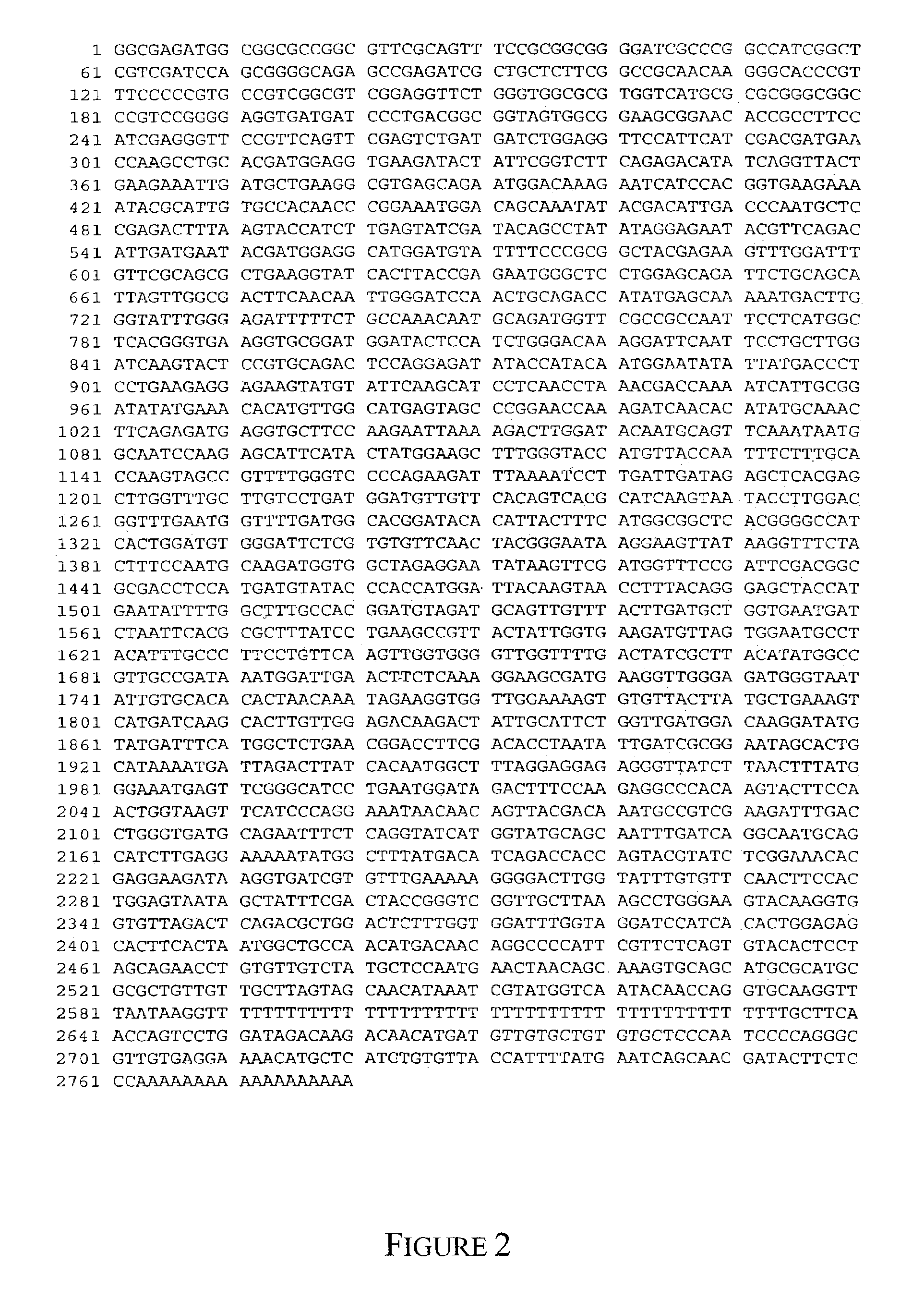Barley with altered branching enzyme activity and starch and starch containing products with an increased amylose content
a branching enzyme and amylose technology, which is applied in the field of barley, can solve the problems of not being able to demonstrate the proposed molecular strategy, suggesting specific reduction of activity, and disadvantages of certain food applications in terms of gelatinisation temperature of most high amylose starches, so as to reduce the level of sbeiia enzyme activity
- Summary
- Abstract
- Description
- Claims
- Application Information
AI Technical Summary
Benefits of technology
Problems solved by technology
Method used
Image
Examples
example 1
Materials and Methods
Callus Inducing Medium
[0105]BCI-DM medium containing Dicamba (2.5 mg / l) was used for callus induction from barley embryo. Composition for one liter of medium:
[0106]
MS salt Macro (10x stock):100mlMS micro (100x stock):10mlIron (200x stock):5mlEDTA (200x stock):5mlMaltose:15.0gThiamine-HCl (1 mg / ml):1mlMyo-inositol:250mgCasein hydrolysate:1gDicamba (1 mg / ml):2.5mlProline:345mg
[0107]The pH was adjusted to 5.8 and 3.5 g / l of Phytagel added. After autoclaving the medium, 150 mg / l of Timentin and 50 mg / l of Hygromycin were added.
[0108]
Barley regeneration mediumBarley calli are regenerated in FHG medium containing BAP (1 mg / l)FHG-I Macro (10x stock):100mlFHG-II Micro (100x stock):10mlThiamine-HCl (1 mg / ml):1mlIron (200x stock):5mlEDTA (200x stock):5mlBAP (1 mg / ml):1mlInositol:100mgGlutamine:730mgMaltose:62g
[0109]The pH was adjusted to 5.8 and then 3.5 g / l of phytagel added. After autoclaving the medium, 150 mg / l of Timentin and 20 mg / l of hygromycin were added.
Carbohyd...
example 2
Isolation of SBE Genes from Barley
Construction of Barley cDNA and Genomic Libraries.
[0117]Barley cDNA and genomic libraries were made by standard methods in phage vectors (Sambrook et al, 1989). A cDNA library was made in the ZipLox vector (Life Technology) according to the protocols supplied with the reagents. The titre of the library was 2×106 pfu tested with Y1090(ZL) strain of E. coli. The barley genomic library, obtained from E. Lagudah (CSIRO), was made from DNA from the variety Morex. The DNA was digested with MboI and ligated to EcoRI / BamHI digested EMBL3 cos vector. Cloned fragments could be released with SalI digestion.
Isolation of SBEIIa and SBEIIb Gene Sequences from a H. vulgare Genomic Library
[0118]Conditions for library screening were hybridisation at 25% formamide, 5×SSC, 0.1% SDS, 10× Denhardts solution, 100 μg / ml salmon sperm DNA at 42° C. for 16 hr, followed by washing with 2×SSC, 0.1% SDS at 65° C. for 3×1 hr (medium stringency). Clones containing the SBEIIa and ...
example 3
Constructs for Transformation Experiments to Alter Barley SBEIIA and SBEIIB Expression
[0120]Duplex-RNA (dsRNA) constructs were made to reduce the expression of either the SBEIIa or SBEIIb genes of barley. In such constructs, the desired nucleic acid sequence corresponding to part of the SBEIIa or SBEIIb genes occurred in both the sense and antisense orientations relative to the promoter so that the expressed RNA comprised complementary regions that were able to basepair and form a duplex or double-stranded RNA. A spacer region between the sense and antisense sequences comprised an intron sequence which, when transcribed as part of the RNA in the transformed plant, would be spliced out to form a tight “hairpin” duplex structure. The inclusion of an intron has been found to increase the efficiency of gene silencing conferred by duplex-RNA constructs (Smith et al., 2000). The desired nucleic acid was linked to a high molecular weight glutenin (HMWG) promoter sequence (promoter of the D...
PUM
| Property | Measurement | Unit |
|---|---|---|
| average weight | aaaaa | aaaaa |
| weight | aaaaa | aaaaa |
| weight | aaaaa | aaaaa |
Abstract
Description
Claims
Application Information
 Login to View More
Login to View More - R&D
- Intellectual Property
- Life Sciences
- Materials
- Tech Scout
- Unparalleled Data Quality
- Higher Quality Content
- 60% Fewer Hallucinations
Browse by: Latest US Patents, China's latest patents, Technical Efficacy Thesaurus, Application Domain, Technology Topic, Popular Technical Reports.
© 2025 PatSnap. All rights reserved.Legal|Privacy policy|Modern Slavery Act Transparency Statement|Sitemap|About US| Contact US: help@patsnap.com



